Assessing and Mapping Changes in Forest Growing Stock Volume over Time in Bashkiriya Nature Reserve, Russia
Abstract
:1. Introduction
2. Materials and Methods
2.1. Study Area
2.2. Field Investigation
2.3. Digital Mapping and Statistical Analyses
3. Results
3.1. Forests Characteristics and Its Changes
3.2. Changes in GSV Rates
3.3. Age Structure of Forests
4. Discussion
4.1. Forests of the Reserve
4.2. Carbon Sequestration by Tree Species
4.3. Further Prospects for the Digital Mapping of Tree Species and GSV
4.4. The Prospect of Applying GSV Results
5. Conclusions
Author Contributions
Funding
Data Availability Statement
Conflicts of Interest
References
- Waring, B.; Neumann, M.; Prentice, I.C.; Adams, M.; Smith, P.; Siegert, M. Forests and Decarbonization—Roles of Natural and Planted Forests. Front. For. Glob. Chang. 2020, 3, 00058. [Google Scholar] [CrossRef]
- Lewis, S.L.; Wheeler, C.E.; Mitchard, E.T.A.; Koch, A. Restoring Natural Forests Is the Best Way to Remove Atmospheric Carbon. Nature 2019, 568, 25–28. [Google Scholar] [CrossRef] [PubMed]
- Gschwantner, T.; Alberdi, I.; Bauwens, S.; Bender, S.; Borota, D.; Bosela, M.; Bouriaud, O.; Breidenbach, J.; Donis, J.; Fischer, C.; et al. Growing Stock Monitoring by European National Forest Inventories: Historical Origins, Current Methods and Harmonisation. For. Ecol. Manag. 2022, 505, 119868. [Google Scholar] [CrossRef]
- Chaudhary, A.; Burivalova, Z.; Koh, L.P.; Hellweg, S. Impact of Forest Management on Species Richness: Global Meta-Analysis and Economic Trade-Offs. Sci. Rep. 2016, 6, 23954. [Google Scholar] [CrossRef] [PubMed]
- Berveglieri, A.; Imai, N.N.; Tommaselli, A.M.G.; Martins-Neto, R.P.; Takahashi Miyoshi, G.; Honkavaara, E. Forest Cover Change Analysis Based on Temporal Gradients of the Vertical Structure and Density. Ecol. Indic. 2021, 126, 107597. [Google Scholar] [CrossRef]
- Manhas, R.K.; Negi, J.D.S.; Kumar, R.; Chauhan, P.S. Temporal Assessment of Growing Stock, Biomass and Carbon Stock of Indian Forests. Clim. Chang. 2006, 74, 191–221. [Google Scholar] [CrossRef]
- Ren, C.; Chen, L.; Wang, Z.; Zhang, B.; Xi, Y.; Lu, C. Spatio-Temporal Changes of Forests in Northeast China: Insights from Landsat Images and Geospatial Analysis. Forests 2019, 10, 937. [Google Scholar] [CrossRef]
- Awad, M.M. Forest Mapping: A Comparison between Hyperspectral and Multispectral Images and Technologies. J. For. Res. 2018, 29, 1395–1405. [Google Scholar] [CrossRef]
- Nitoslawski, S.A.; Wong-Stevens, K.; Steenberg, J.W.N.; Witherspoon, K.; Nesbitt, L.; Konijnendijk van den Bosch, C.C. The Digital Forest: Mapping a Decade of Knowledge on Technological Applications for Forest Ecosystems. Earth’s Futur. 2021, 9, e2021EF002123. [Google Scholar] [CrossRef]
- Wang, X.; Wang, S.; Dai, L. Estimating and Mapping Forest Biomass in Northeast China Using Joint Forest Resources Inventory and Remote Sensing Data. J. For. Res 2018, 29, 797–811. [Google Scholar] [CrossRef]
- Biembetov, A.; Yanybayev, N.; Valiev, I. The State of Mountain Forest Ecosystems in the Bashkir Nature Reserve (Southern Urals). BIO Web Conf. 2021, 35, 00006. [Google Scholar] [CrossRef]
- Moiseev, P.A.; Bubnov, M.O.; Moiseeva, O.O.; Gaisin, I.K. Dynamics Of Tree Vegetation In Steppificated Areas On The Slopes Of The Southern Kraka Massif During The Past 80 Years. Russ. J. Ecol. 2018, 49, 157–162. [Google Scholar] [CrossRef]
- Martynenko, V.B.; Solomeshch, A.I.; Zhirnova, T.V. Forests of the Bashkir State Nature Reserve: Syntaxonomy and Environmental Significance; Gilem: Ufa, Russia, 2003. [Google Scholar]
- Anuchin, N.P. Forest Taxation; Forestry Industry: Moscow, Russia, 1982. [Google Scholar]
- Zagreev, V.V.; Sukhikh, V.I.; Shvydenko, A.Z.; Gusev, N.N.; Moshkalev, A.G. All-Union Standards for Forest Taxation: Handbook; Kolos: Moscow, Russia, 1992. [Google Scholar]
- Law, B.E.; Berner, L.T.; Buotte, P.C.; Mildrexler, D.J.; Ripple, W.J. Strategic Forest Reserves Can Protect Biodiversity in the Western United States and Mitigate Climate Change. Commun. Earth Environ. 2021, 2, 254. [Google Scholar] [CrossRef]
- Zamolodchikov, D.G.; Grabovskii, V.I.; Kraev, G.N. A Twenty Year Retrospective on the Forest Carbon Dynamics in Russia. Contemp. Probl. Ecol. 2011, 4, 706–715. [Google Scholar] [CrossRef]
- Gabbasova, I.M.; Garipov, T.T.; Suleimanov, R.R.; Komissarov, M.A.; Khabirov, I.K.; Sidorova, L.V.; Nazyrova, F.I.; Prostyakova, Z.G.; Kotlugalyamova, E.Y. The Influence of Ground Fires on the Properties and Erosion of Forest Soils in the Southern Urals (Bashkir State Nature Reserve). Eurasian Soil Sc. 2019, 52, 370–379. [Google Scholar] [CrossRef]
- Gazizov, A.M.; Sagitova, A.B.; Sharafutdinov, M.I. The Dynamics of Forest Fires and Their Impact on the Environment. IOP Conf. Ser. Earth Environ. Sci. 2022, 981, 032025. [Google Scholar] [CrossRef]
- Suleymanov, R.; Yakimov, M.; Liebelt, P.; Shirokikh, P.; Suleymanov, A.; Abakumov, E.; Adelmurzina, I.; Bakieva, E.; Asylbaev, I. Transformation of Plant and Soil Covers of the Botanical Nature Monument “Pine Forest near Venetsiya Village” (Russia) as a Result of a Windfall. Eurasian J. Soil Sci. 2021, 10, 251–258. [Google Scholar] [CrossRef]
- Bogdan, E.A.; Kamalova, R.G.; Suleymanov, A.; Belan, L.N.; Tuktarova, I. Changing Climatic Indicators and Mapping of Soil Temperature Using Landsat Data in the Yangan-Tau Unesco Global Geopark. SOCAR Proc. 2022, 2022, 32–41. [Google Scholar] [CrossRef]
- Sobol, N.V.; Gabbasova, I.M.; Komissarov, M.A. Impact of Climate Changes on Erosion Processes in Republic of Bashkortostan. Arid Ecosyst. 2015, 5, 216–221. [Google Scholar] [CrossRef]
- Suleymanov, R.; Garipov, T.; Suleymanov, A.; Nazyrova, F.; Komissarov, M.; Sidorova, L.; Gabbasova, I. The Retrospective Monitoring of Soils under Conditions of Climate Change in the Trans-Ural Region (Russia). J. Water L. Dev. 2022, 55, 84–90. [Google Scholar]
- Lawrence, D.; Coe, M.; Walker, W.; Verchot, L.; Vandecar, K. The Unseen Effects of Deforestation: Biophysical Effects on Climate. Front. For. Glob. Chang. 2022, 5, 756115. [Google Scholar] [CrossRef]
- Gaisin, I.K.; Moiseev, P.A.; Balakin, D.S.; Nagimov, Z.Y. The Structure of Tree Stands and Features of Their Phytomass Accumulation on the Steppified Slopes of the Kraka Mountain Massif (Southern Urals). Vestn. Tomsk. Gos. Univ. Biol. 2021, 56, 125–151. [Google Scholar] [CrossRef]
- Gaisin, I.K.; Moiseev, P.A.; Makhmutova, I.I.; Nizametdinov, N.F.; Moiseeva, O.O. Expansion Of Tree Vegetation In The Forest–Mountain Steppe Ecotone On The Southern Urals In Relation To Changes In Climate And Habitat Moisture. Russ. J. Ecol. 2020, 51, 251–264. [Google Scholar] [CrossRef]
- Usoltsev, V.A. Carbon Sequestration by Forests of the Ural Region of Russia (on the Base of Forest State Inventory Data 2007); Monograph; Ural State Forest Engineering University: Yekaterinburg, Russia, 2018. [Google Scholar]
- Volkov, A.; Belan, L.; Bogdan, E.; Suleymanov, A.; Tuktarova, I.; Shagaliev, R.; Muftakhina, D. Spatio-Temporal Analysis of Forest Growing Stock Volume and Carbon Stocks: A Case Study of Kandry-Kul Natural Park, Russia. Land 2023, 12, 1441. [Google Scholar] [CrossRef]
- Fassnacht, F.E.; Latifi, H.; Stereńczak, K.; Modzelewska, A.; Lefsky, M.; Waser, L.T.; Straub, C.; Ghosh, A. Review of Studies on Tree Species Classification from Remotely Sensed Data. Remote Sens. Environ. 2016, 186, 64–87. [Google Scholar] [CrossRef]
- Wang, M.; Zheng, Y.; Huang, C.; Meng, R.; Pang, Y.; Jia, W.; Zhou, J.; Huang, Z.; Fang, L.; Zhao, F. Assessing Landsat-8 and Sentinel-2 Spectral-Temporal Features for Mapping Tree Species of Northern Plantation Forests in Heilongjiang Province, China. For. Ecosyst. 2022, 9, 100032. [Google Scholar] [CrossRef]
- Sothe, C.; de Almeida, C.M.; Liesenberg, V.; Schimalski, M.B. Evaluating Sentinel-2 and Landsat-8 Data to Map Sucessional Forest Stages in a Subtropical Forest in Southern Brazil. Remote Sens. 2017, 9, 838. [Google Scholar] [CrossRef]
- Michałowska, M.; Rapiński, J. A Review of Tree Species Classification Based on Airborne Lidar Data and Applied Classifiers. Remote Sens. 2021, 13, 353. [Google Scholar] [CrossRef]
- Brilli, L.; Chiesi, M.; Brogi, C.; Magno, R.; Arcidiaco, L.; Bottai, L.; Tagliaferri, G.; Bindi, M.; Maselli, F. Combination of Ground and Remote Sensing Data to Assess Carbon Stock Changes in the Main Urban Park of Florence. Urban For. Urban Green. 2019, 43, 126377. [Google Scholar] [CrossRef]
- Raciti, S.M.; Hutyra, L.R.; Newell, J.D. Mapping Carbon Storage in Urban Trees with Multi-Source Remote Sensing Data: Relationships between Biomass, Land Use, and Demographics in Boston Neighborhoods. Sci. Total Environ. 2014, 500–501, 72–83. [Google Scholar] [CrossRef]
- Lee, H.; Wang, J.; Leblon, B. Using Linear Regression, Random Forests, and Support Vector Machine with Unmanned Aerial Vehicle Multispectral Images to Predict Canopy Nitrogen Weight in Corn. Remote Sens. 2020, 12, 2071. [Google Scholar] [CrossRef]
- Waldeland, A.U.; Trier, Ø.D.; Salberg, A.B. Forest Mapping and Monitoring in Africa Using Sentinel-2 Data and Deep Learning. Int. J. Appl. Earth Obs. Geoinf. 2022, 111, 102840. [Google Scholar] [CrossRef]
- Miftakhova, S.; Abramova, L.; Saifullina, N.; Yusupova, O. Crop Wild Relatives in the Protected Areas of the Republic of Bashkortostan. Proc. Appl. Bot. Genet. Breed. 2022, 183, 181–191. [Google Scholar] [CrossRef]
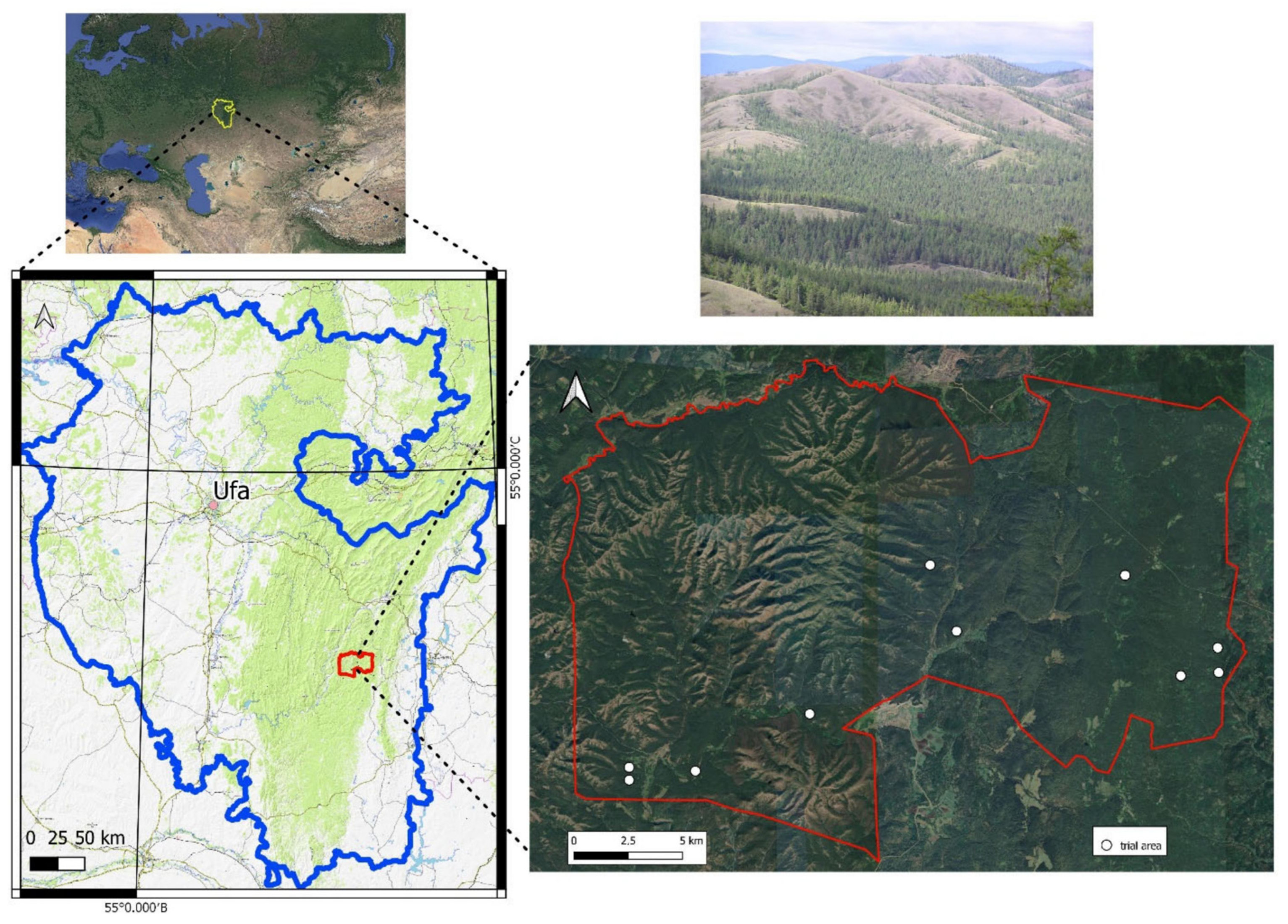
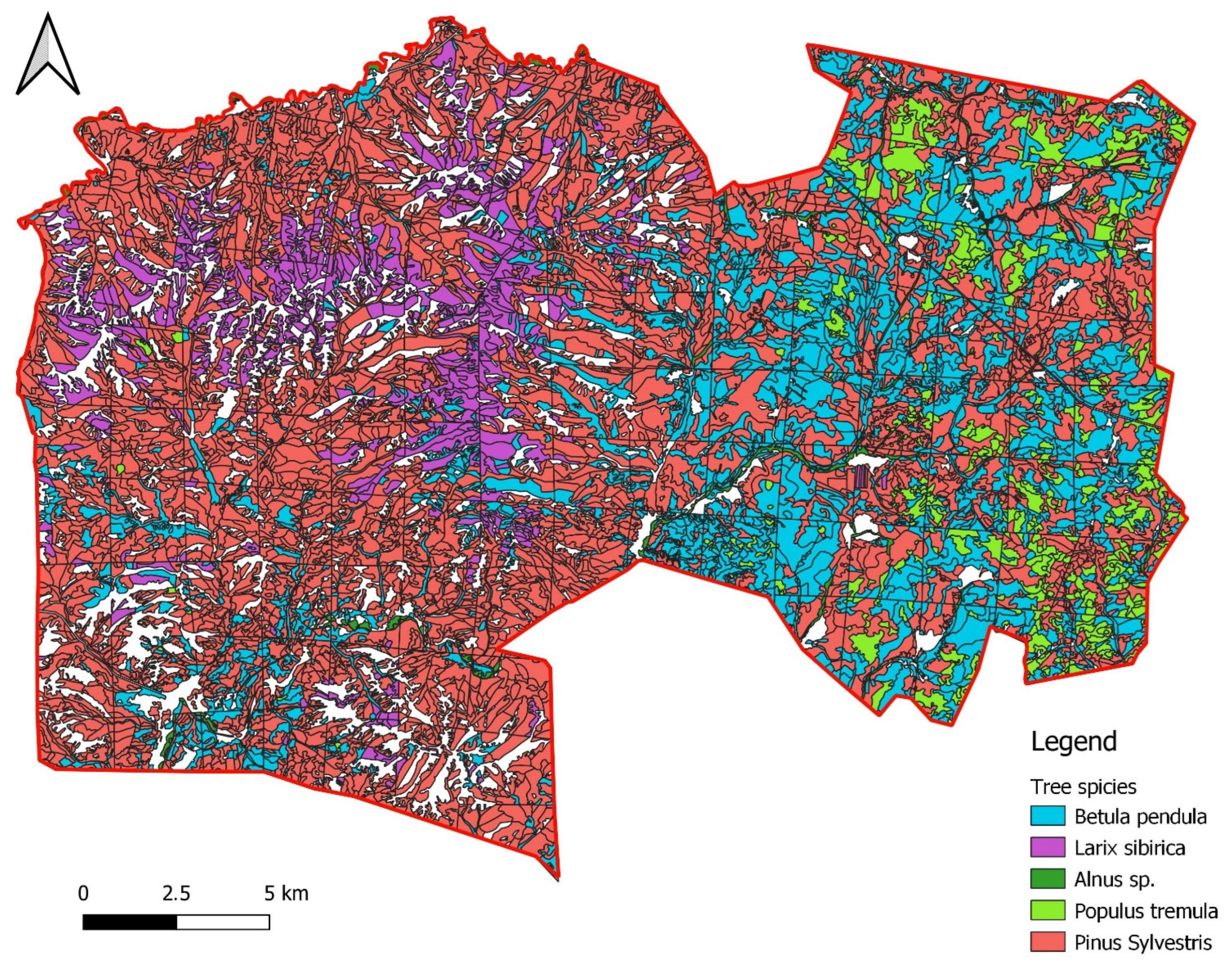
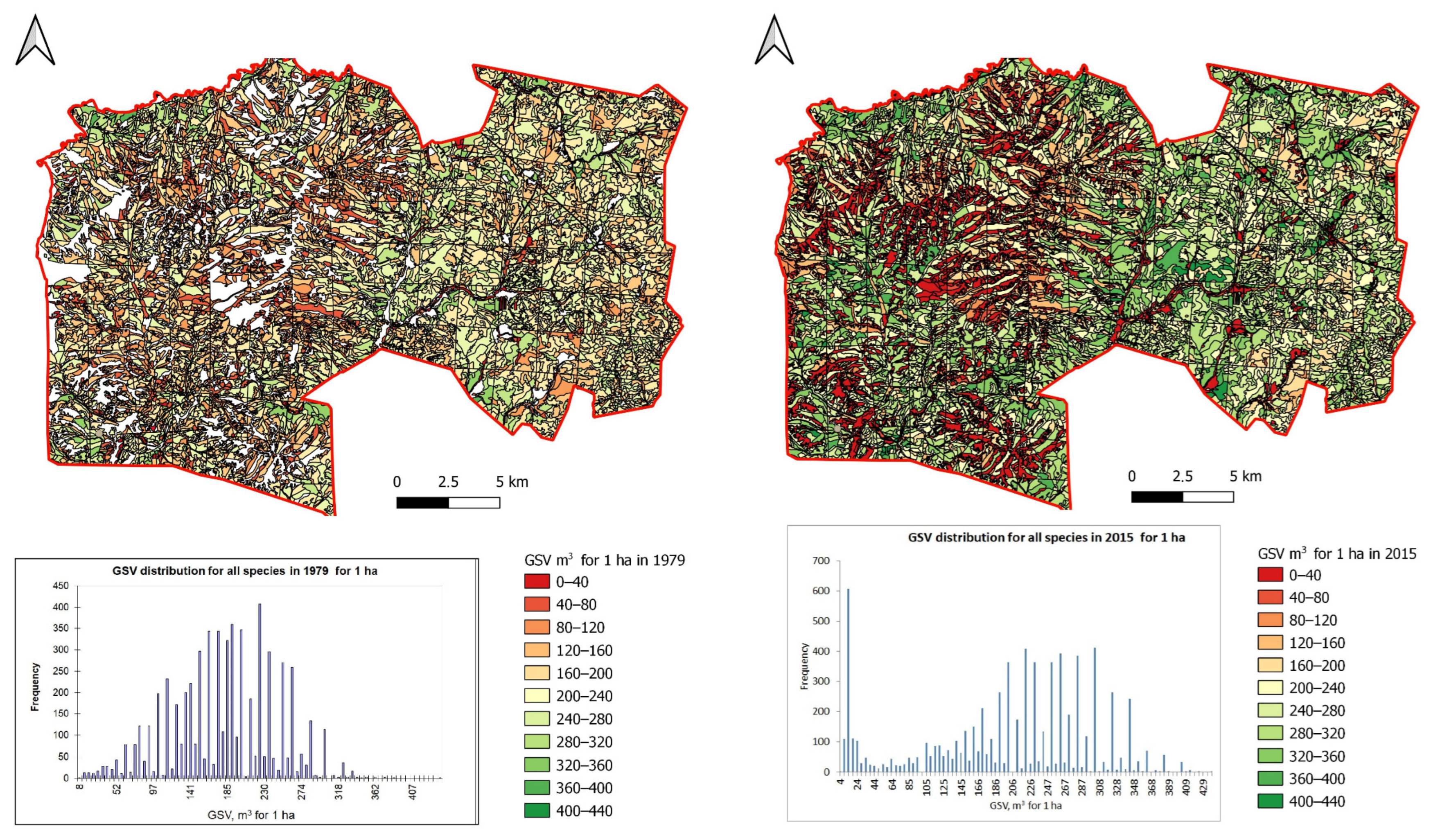
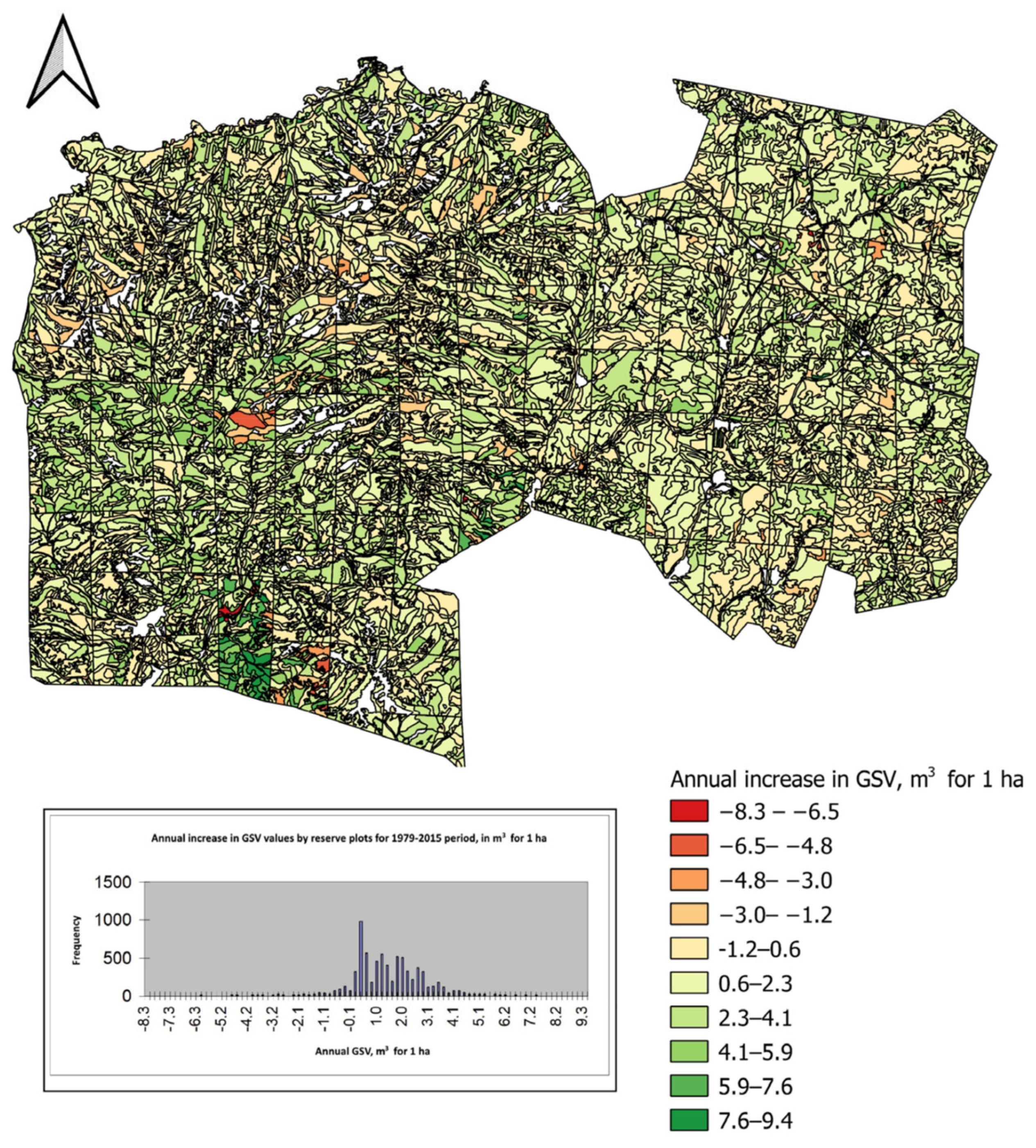
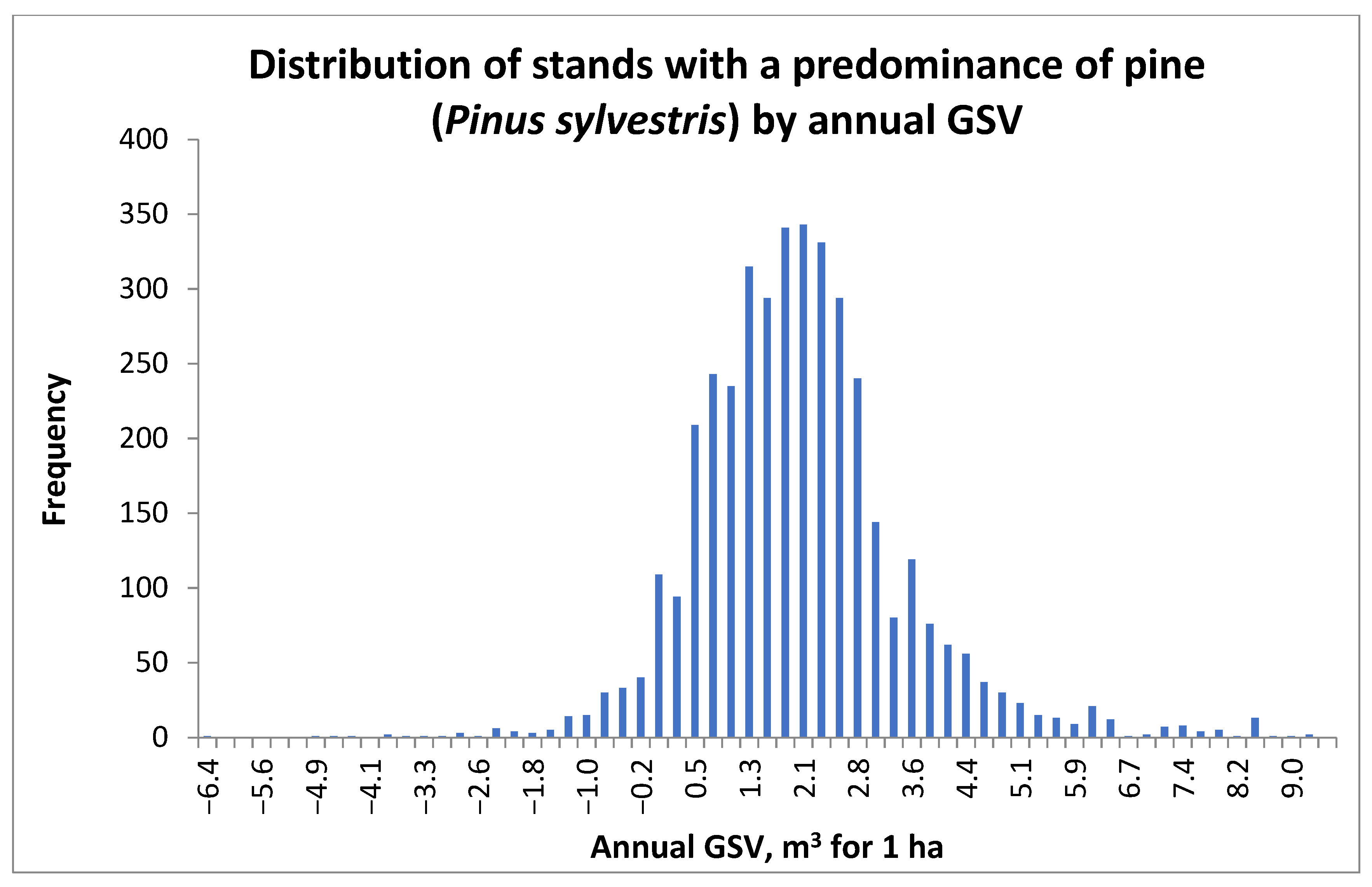

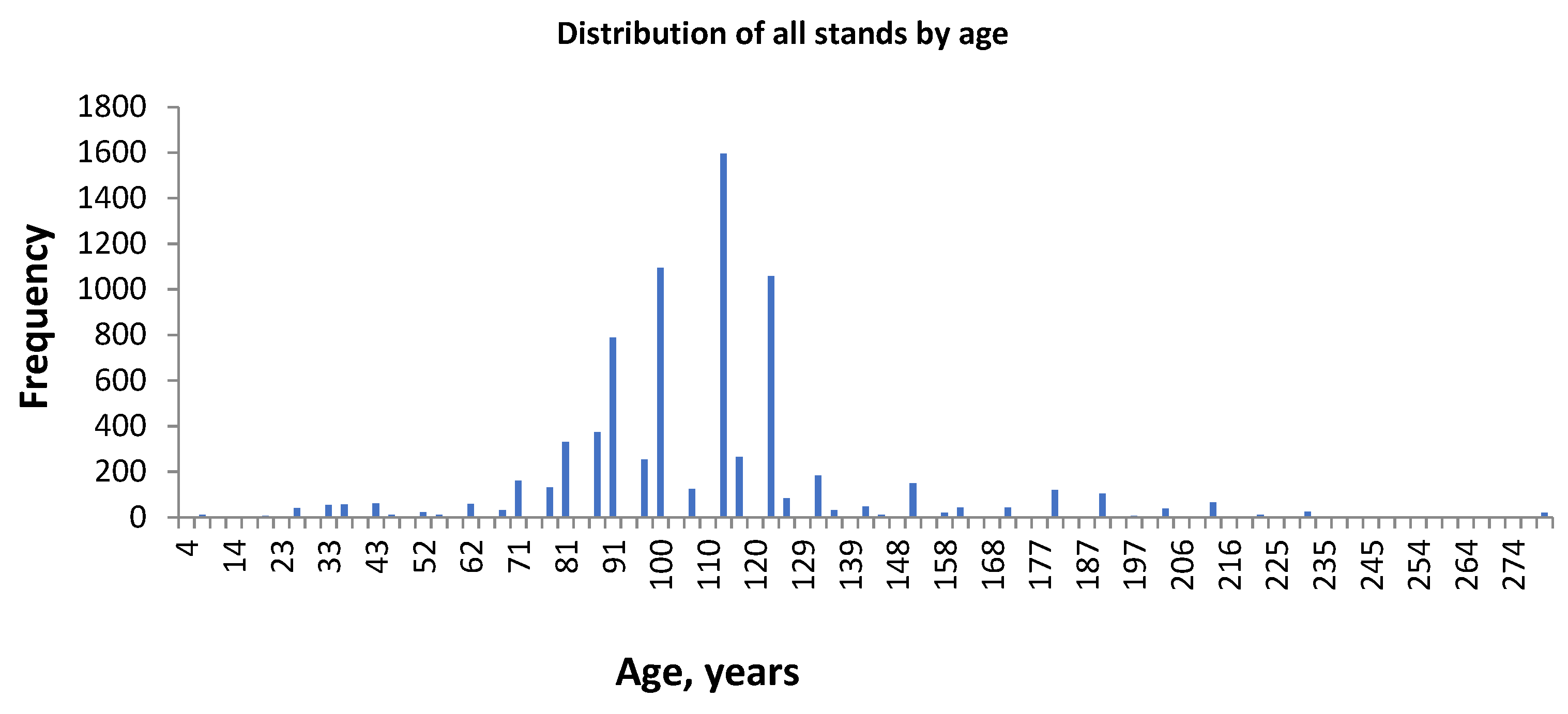
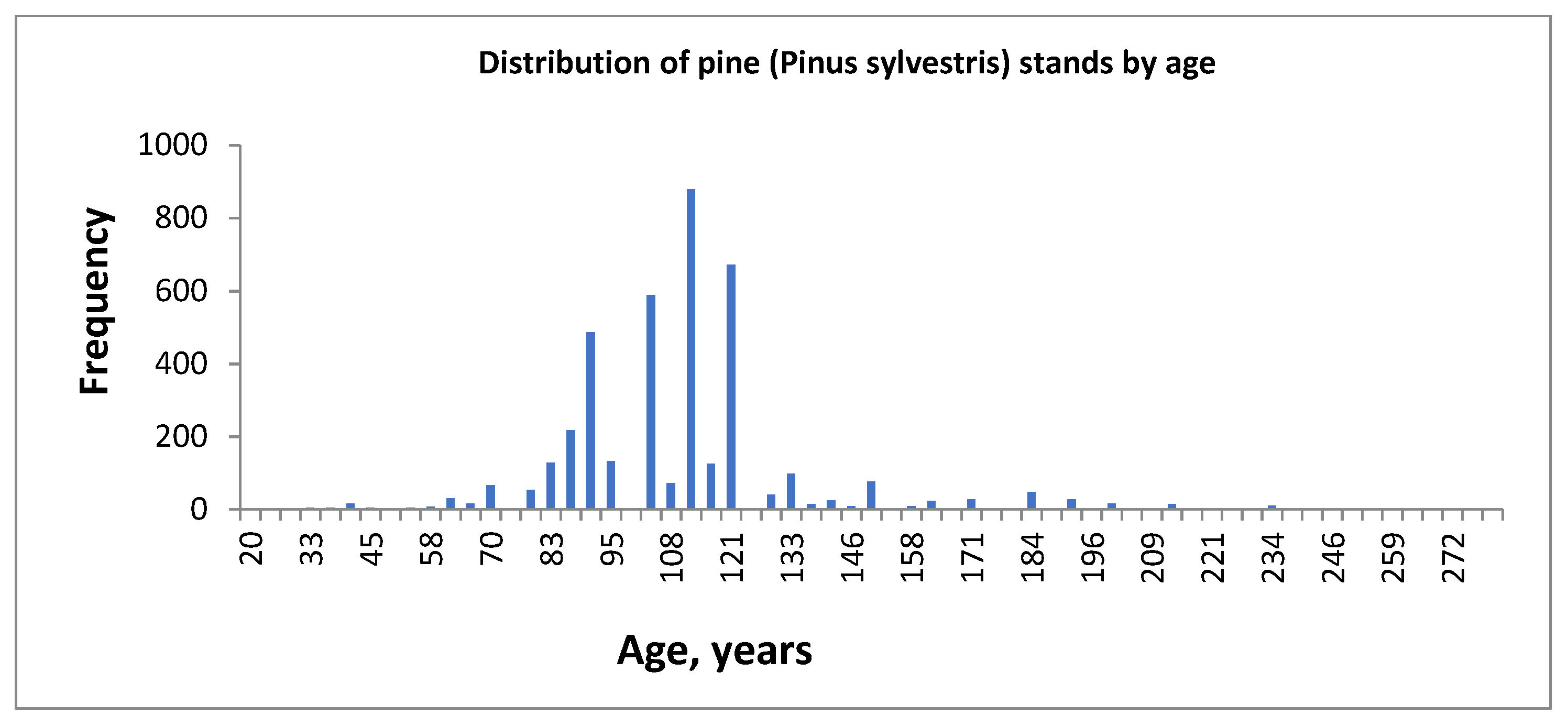
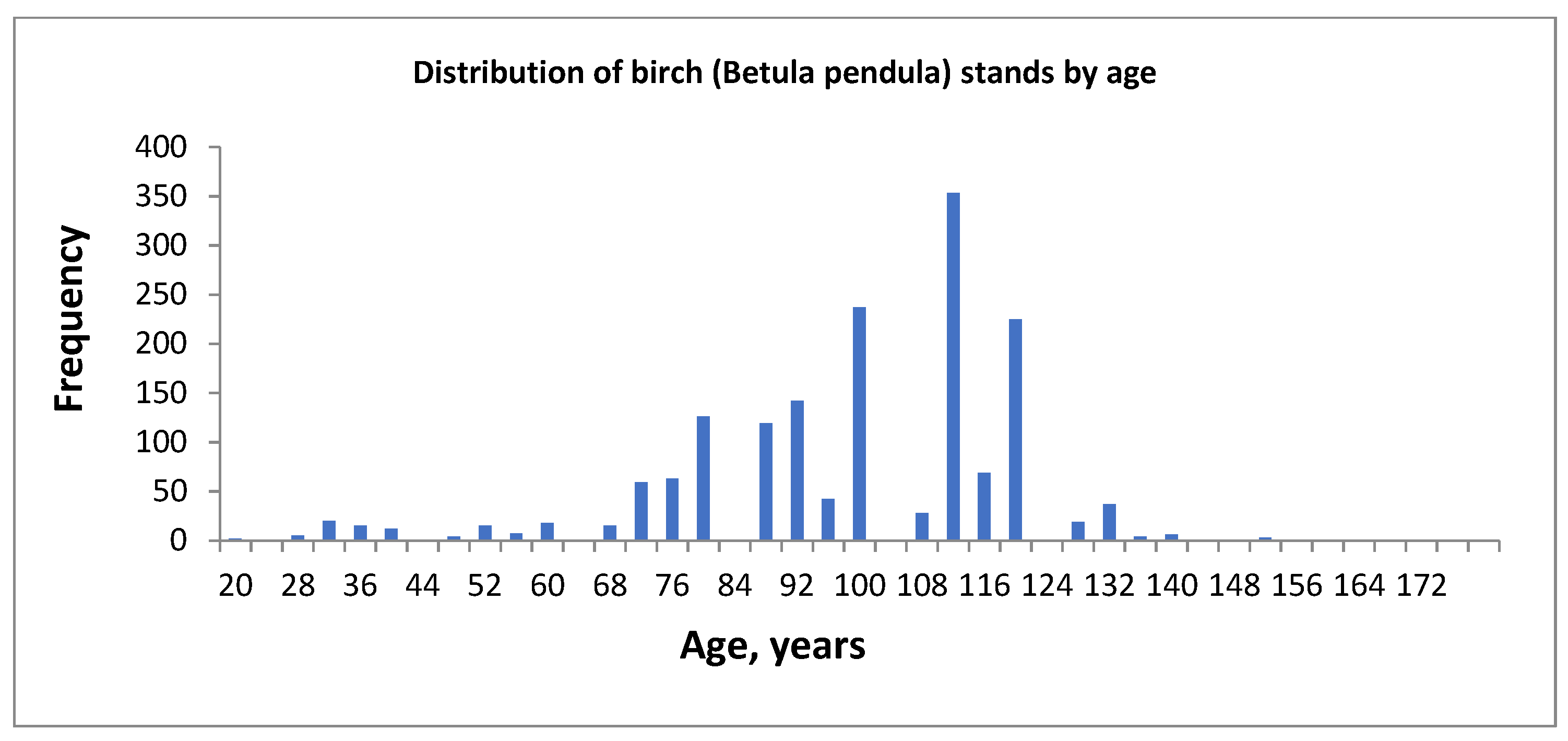
| Age | Area, km2 | GSV, m3 2015 | Difference, m3 2015–1979 | Proportion of Total Area, % | Proportion of Total GSV, % |
|---|---|---|---|---|---|
| Birch (Betula pendula) | |||||
| 20–30 | 116.9 | 13,622.24 | 9060.69 | 0.4532 | 0.0027 |
| 31–40 | 161.9 | 24,373.72 | 23,093.25 | 0.6277 | 0.0049 |
| 41–50 | 79.6 | 10,353.97 | 7028.68 | 0.3086 | 0.0021 |
| 51–60 | 61.5 | 15,212.95 | 6689.91 | 0.2384 | 0.0030 |
| 61–135 | 2841.6 | 25,415,452.26 | 8,051,196.21 | 11.0170 | 5.0932 |
| Larch (Larix sibirica) | |||||
| 20–40 | 131.1 | 27,500.45 | 25,009.55 | 0.5083 | 0.0055 |
| 60–80 | 74.3 | 22,169.19 | 10,180.81 | 0.2881 | 0.0044 |
| 81–100 | 522 | 1,108,896.61 | 347,536.64 | 2.0238 | 0.2222 |
| 101–120 | 509.02 | 815,590.02 | 755,774.06 | 1.9735 | 0.1634 |
| 121–140 | 280.3 | 1,786,113.65 | 1,643,219.23 | 1.0867 | 0.3579 |
| 141–280 | 1995.3 | 6,140,619.55 | −1,919,769.91 | 7.7358 | 1.2306 |
| Alder (Alnus sp.) | |||||
| 20–30 | 60.4 | 5241.15 | −4897.90 | 0.2342 | 0.0011 |
| 31–40 | 147.3 | 35,943.70 | −12,759.86 | 0.5711 | 0.0072 |
| 45 | 9.7 | 133.85 | 20.14 | 0.0376 | 0.0000 |
| 70 | 6.7 | 27.00 | −2.77 | 0.0260 | 0.0000 |
| Aspen (Populus tremula) | |||||
| 70–115 | 60.8 | 17,420.90 | 4140.72 | 0.2357 | 0.0035 |
| Pine (Pinus sylvestris) | |||||
| 20–40 | 202.7 | 52,714.57 | 45,830.47 | 0.7859 | 0.0106 |
| 41–60 | 148.8 | 102,030.08 | 58,714.10 | 0.5769 | 0.0204 |
| 61–80 | 1099.6 | 6,272,568.14 | 2,777,934.87 | 4.2632 | 1.2570 |
| 81–100 | 7292.4 | 207,951,835.87 | 72,291,369.72 | 28.2729 | 41.6728 |
| 101–120 | 8117.8 | 243,773,515.69 | 59,962,697.95 | 31.4730 | 48.8513 |
| 121–140 | 520.1 | 1,031,592.87 | 261,268.07 | 2.0164 | 0.2067 |
| 141–280 | 1353.1 | 4,388,212.90 | 246,061.24 | 5.2460 | 0.8794 |
| Age | Area, km2 | GSV m3 2015 | Difference, m3 2015–1979 | Proportion of Total Area, % | Proportion of Total GSV, % |
|---|---|---|---|---|---|
| Birch (Betula pendula) | |||||
| 30–40 | 4.6 | 158.81 | 143.63 | 0.0370 | 0.0002 |
| 41–50 | 5.2 | 104.94 | 93.40 | 0.0418 | 0.0001 |
| 51–60 | 2.3 | 23.00 | 14.64 | 0.0185 | 0.0000 |
| 61–150 | 3324.9 | 8,686,612.19 | 1,739,105.22 | 26.7222 | 9.6660 |
| Larch (Larix sibirica) | |||||
| 47–50 | 1.0 | 19.00 | 18.17 | 0.0080 | 0.0000 |
| Alder (Alnus sp.) | |||||
| 0–20 | 3.2 | 16.00 | 8.00 | 0.0257 | 0.0000 |
| 21–30 | 35.3 | 883.03 | −326.98 | 0.2837 | 0.0010 |
| 31–40 | 43.2 | 1309.74 | 573.26 | 0.3472 | 0.0015 |
| 60–70 | 4.4 | 191.22 | 47.14 | 0.0350 | 0.0002 |
| Aspen (Populus tremula) | |||||
| 0–10 | 19.4 | 56.70 | −1787.93 | 0.1558 | 0.0001 |
| 60–130 | 2159.5 | 5,600,350.44 | 870,074.49 | 17.3559 | 6.2318 |
| Pine (Pinus sylvestris) | |||||
| 40–60 | 42.3 | 8074.90 | 6969.94 | 0.3400 | 0.0090 |
| 61–80 | 57.0 | 19,651.61 | 9993.87 | 0.4581 | 0.0219 |
| 81–100 | 1222.2 | 6,962,712.07 | 1,941,623.59 | 9.8228 | 7.7477 |
| 101–120 | 4321.0 | 66,917,615.88 | 11,844,707.92 | 34.7279 | 74.4621 |
| 121–140 | 531.6 | 1,014,756.89 | 135,041.28 | 4.2725 | 1.1292 |
| 141–220 | 665.4 | 655,437.47 | 77,278.06 | 5.3478 | 0.7293 |
Disclaimer/Publisher’s Note: The statements, opinions and data contained in all publications are solely those of the individual author(s) and contributor(s) and not of MDPI and/or the editor(s). MDPI and/or the editor(s) disclaim responsibility for any injury to people or property resulting from any ideas, methods, instructions or products referred to in the content. |
© 2023 by the authors. Licensee MDPI, Basel, Switzerland. This article is an open access article distributed under the terms and conditions of the Creative Commons Attribution (CC BY) license (https://creativecommons.org/licenses/by/4.0/).
Share and Cite
Belan, L.; Suleymanov, A.; Bogdan, E.; Volkov, A.; Gaysin, I.; Tuktarova, I.; Shagaliev, R. Assessing and Mapping Changes in Forest Growing Stock Volume over Time in Bashkiriya Nature Reserve, Russia. Forests 2023, 14, 2251. https://doi.org/10.3390/f14112251
Belan L, Suleymanov A, Bogdan E, Volkov A, Gaysin I, Tuktarova I, Shagaliev R. Assessing and Mapping Changes in Forest Growing Stock Volume over Time in Bashkiriya Nature Reserve, Russia. Forests. 2023; 14(11):2251. https://doi.org/10.3390/f14112251
Chicago/Turabian StyleBelan, Larisa, Azamat Suleymanov, Ekaterina Bogdan, Aleksandr Volkov, Ildar Gaysin, Iren Tuktarova, and Ruslan Shagaliev. 2023. "Assessing and Mapping Changes in Forest Growing Stock Volume over Time in Bashkiriya Nature Reserve, Russia" Forests 14, no. 11: 2251. https://doi.org/10.3390/f14112251
APA StyleBelan, L., Suleymanov, A., Bogdan, E., Volkov, A., Gaysin, I., Tuktarova, I., & Shagaliev, R. (2023). Assessing and Mapping Changes in Forest Growing Stock Volume over Time in Bashkiriya Nature Reserve, Russia. Forests, 14(11), 2251. https://doi.org/10.3390/f14112251








